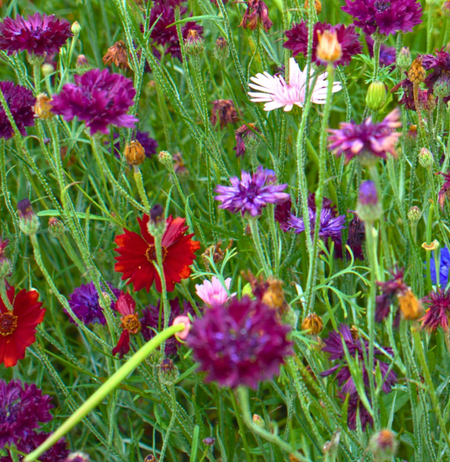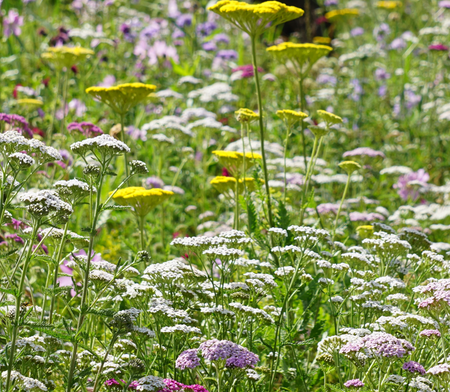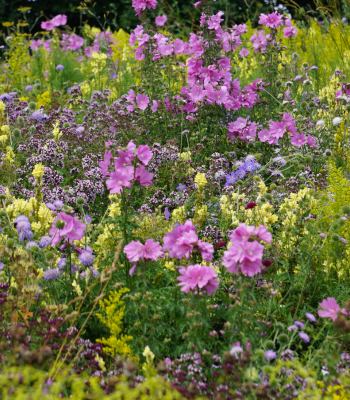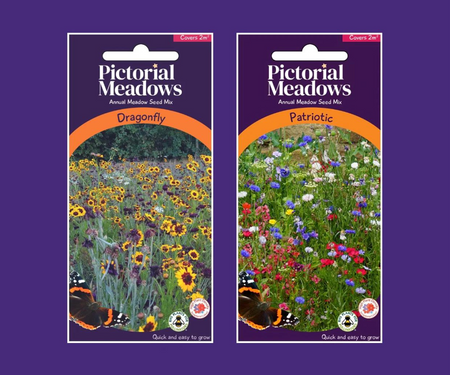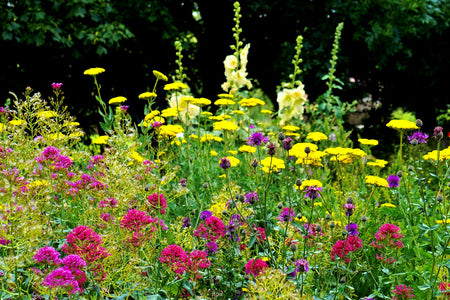How many years can I expect my perennial meadow to look great?
If you established your meadow correctly, it's an open sunny free draining site, your soil fertility isn’t high, and you manage it appropriately it should last forever!
It will always be changing and evolving, not all species will survive and new wild flowers and grasses will also settle in but meadows are one of the most sustainable flowering landscape features you can have. The first 3-5 years though are critical to ensure that this delicate balance is both possible on your site and you have got all the ingredients right.
What are the essential tasks I must do to keep my meadow in good condition?
It doesn’t matter whether your perennial meadow was established by seed or turf the one absolutely essential annual task is the ‘cut and collect’.
This means cutting all the seasons meadow growth down close to the ground and raking and removing all arising material. Sometimes you might want to also undertake an early summer cut and collect to control vigour and get more light down to the smaller plants. In addition, keeping any invading coarse weeds and grasses to the bare minimum especially in the early years really helps.
Why is the cut and collect so important?
Access to light is the most critical factor in achieving and sustaining species diversity within your meadow. The annual cut and collect ensures that all species get access to light in the spring. In addition an annual cut prevents invading woody plants such as tree seedlings and brambles from slowly taking over. The removal of all arisings annually then helps to deplete the soils of nutrients which in turn reduces the subsequent vigour of the plants in the meadow – and the less vigorous they are the more they all get that light as well!
How low should I cut and what do I use?
We would recommend cutting to about 100mm on average although some species thrive on cuts even lower. How its done depends on the size of the site. For a smaller meadow this can be done with a hedge cutter, a strimmer or a mower. For a larger meadow a tractor mount cut and collect will make it much easier. Do not leave the arisings lying across the meadow as is often recommended in conservation meadows. A Pictorial Meadow is different. Always make sure any arisings are collected as soon as possible to reduce the likelihood of rotting and shading out small ground cover species and leaching of nutrients from the green stems back into the soil
When should I cut my perennial meadow?
When to cut your meadow varies for person depending on how you want your meadow to look and what you want to achieve from it. If you have a mix that mostly flowers early on in the season, we would recommend an early summer cut to produce a second flush of flowers in the Autumn, such as with our Woodland Edge mix and Woodland Fringe turf. Low growing meadows such as Pollinator Verge and Pollinator Lawn are best with several extra spring and early summer cuts. All meadows should receive an end of season cut and collect but this can be anytime from mid Autumn right through to mid February. The later the cut the greater the wildlife benefit. In addition it means that there will generally be (i) less weed invasion because there is more ground cover
(ii) better root growth as nutrients are returned naturally (iii) the arising will be easier to cut and less bulky to dispose of. Earlier cuts are recommended only if you feel the meadow is visually less appealing or you need to get the job done! If you have large areas of meadow, or a range of different meadow mixes, it can be really beneficial to zone and cut areas at different times of the year. For example, some areas may be cut in mid-summer, other areas cut in late summer, and other areas left until late winter. By having areas with different cutting times, this will provide conditions for the widest array of plants to thrive and also provide better habitats for wildlife.
Is it important to check any obvious weeds and what’s the best time and way to do this?
It is important, especially in the early years to control the more competitive invading weeds, such as docks, thistles, nettles and brambles. Left completely unchecked they will outcompete many of the desirable species especially on more nutrient rich soils. Perennial weeds can be removed by hand, or spot treated with an appropriate herbicide. The ideal time to check and carry out this operation is mid spring when the weeds are visible but the surrounding meadow is just greening up. A 2nd check in summer is useful and in particular look for any coarse weeds that might have escaped your earlier attention and just prevent them from flowering simply by cutting off the flowering heads wherever accessible. The end of year cut and collect will deal with more woody plants and annuals. Occasionally, sometimes in the early years of a seed sown perennial meadow, there can be a flush of annual weeds such as Cleaver or Fat Hen emerging from the seed bank. If too many to pull out, then a late spring cut and collect across the whole meadow is a simple and effective way of breaking this cycle. The meadow will spring back and flower, just a little later and shorter than normal.
My perennial meadow doesn’t look like the images on your website or catalogue. Why not?
All of the images we use are of our meadows but even though the mix recipe will be the same, everyone’s meadow will develop its own unique characteristics. These will then continue to change, evolve and adapt to local site conditions, then throughout the season and from year to year. Change is the only constant!
I have an area of really species rich grassland. Should I dig it up to establish a Pictorial Meadow?
No. Species rich grasslands should be conserved and managed appropriately and it is bad practice to introduce anything new into it and that includes so called ‘native’ seed mixes or even native plug plants. If you want the longevity and additional floral and pollinator interest that a Pictorial Meadow provides however you can consider converting existing flower or shrub borders in the garden area to Pictorial Meadows or introducing just a narrow ‘transitional’ edge of a Pictorial Meadow at one or two key locations or along say the border between a mown lawn and a conservation meadow.
Do I need to water my meadow in the summer if it gets very hot and dry?
No, meadows can tolerate stress, in fact it is good for them and whilst watering may make the meadow look temporarily fresher and greener it actually promotes over ‘leggy’ green growth at the cost of deeper roots and more flowers.
I have a special event coming up and I want my perennial meadow to be looking at its best at that time. Any advice on how to achieve this?
We recommend that you do an additional cut and collect across the meadow 8 to 10 weeks before the special event and then allow it to regrow and flower.
This works really well for a timed summer or autumn event. Most years nothing else is required but if a hot dry spell takes place in the first month after the cut and collect then be prepared to give the meadow a lot of irrigation just until the plants are all showing really good recovery.
How do I distinguish between weeds and wildflowers?
It takes time and experience but remember that we are always here to help.
Please send us a few good quality digital images of the section in question so we can identify what is going on and hopefully then help you to take the best decision.
Can you tell me what meadow plants I can expect to find in my mix?
You can now download data sheets for all our mixes and these will tell you what to look out for.
I really feel I need help to get my meadow established and/or looked after in the longer term. Do you offer an establishment and maintenance service?
Yes we believe that we offer the best specialist meadow support services across the UK and can help you with anything from initial site audits and design work through to development and production of bespoke mixes, full establishment, maintenance and management services - and for any form of meadow, not just our PM Products! Our technical staff will also always try and help you on the phone or by email with any technical questions
Call our expert team on 0114 2677635 during office hours (8.00-16.00 Monday to Friday) or email us on info@pictorialmeadows.co.uk

